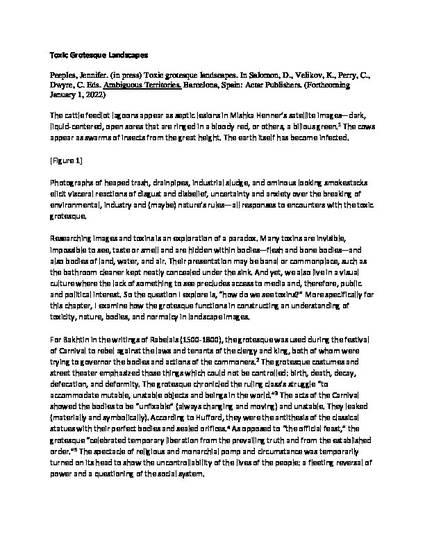
Contribution to Book
Toxic Grotesque
Ambiguous Territory: Architecture, Landscape and the Postnatural
(2022)
Abstract
Oozing, open sores on the landscape as seen in satellite images of factory farming. Unearthly, monotone gray scenes of mining sludge covered basins. These images elicit the visceral reactions of disgust and disbelief over what is being seen, and uncertainty and anxiety over the breaking of environmental, industrial and (maybe) nature’s rules--all responses to encounters with the grotesque. The material, physical grotesque can be difficult to look at. Social norms whisper into audiences’ ears reminding them not to stare. Legal rulings create further restrictions, such as the “ag-gag” laws in Utah and Iowa that prohibits activist photography of CAFOs and animal cruelty. And yet, as Bakhtin (1941) argues, the grotesque has immense emancipatory powers. Like its toxic counterpart, Bakhtin’s carnival use of the grotesque focuses on bodies, the corporeal, its leakages, decay and ultimately death. While it was once used to question the power of the king, Istvan (2008) maintains that it is used in works of fiction to problematize the hegemonic discourses of science and technology. The fear of the grotesque comes from the concern that materiality is out of order. What the audience believes to be scientific truths (or in the case of toxins, the accompanying environmental, social, cultural or political truths) are unstable and chaotic. This presentation introduces the concept of the toxic grotesque. Examining textual representations, it asks in what ways images of the toxic grotesque function to influence the viewing audience’s understanding of the “natural,” the “normal,” science and toxicity.
Keywords
- visual rhetoric,
- toxins,
- grotesque
Disciplines
Publication Date
January 1, 2022
Editor
by Chris Perry (Author), David Salomon (Author), Kathy Velikov (Author), Catherine Ingraham (Author), Cathryn Dwyre (Editor)
Publisher
Actar
ISBN
978-1948765657
Publisher Statement
Ambiguous Territory brings together the work of over forty architects, landscape architects, artists, and historians engaged in an exploration of art and design’s place in a time of environmental uncertainty and existential threat. Conceived in both environmental and disciplinary terms, the concept of “ambiguous territory” seeks to define conditions of uncertainty between nature and culture as well as architecture, art, and landscape. Ambiguous Territory advances the argument that it is through such forms of transdisciplinary practice that new opportunities emerge for creative thinking about our changing relationship to the Earth.
What stories can art and design tell about the effects of global warming and its fundamental reordering of our perceived distinction between nature and culture? Ambiguous Territory brings together the work of architects, landscape architects, artists, and historians to present stories and depictions of a postnatural world and its effects of alienation on traditional forms of identity and meaning.
Initially staged as an exhibition and related symposium at the Taubman College of Architecture and Urban Planning at the University of Michigan before traveling to the Elmaleh Gallery at the University of Virginia, Pratt Manhattan Gallery, and Handwerker Gallery at Ithaca College, the work included in this volume can be seen to engage estrangement as a productive site of intellectual and creative potential. Resisting at once naive optimism and cynical pessimism about the place of art and design in a time of environmental uncertainty and existential threat, Ambiguous Territory explores a opportunities for creative thinking and aesthetic practices that question as well as reinvent our relationship to the Earth, enabling us to see things anew, or simply to probe where we might be heading. Out of what kind of fog? Into what kind of New World?
With Contributions of Ellie Abrons, Paula Gaetano Adi, amid.cero9, Amy Balkin, Philip Beesley, Ursula Biemann, The Bittertang Farm, Edward Burtynsky, Bradley Cantrell, Gustavo Crembil, Brian Davis, Design Earth, Mark Dion, Formlessfinder, Lindsey french, Adam Fure, Futureforms, Michael Geffel, Rania Ghosn, David Gissen, El Hadi Jazairy, Harrison Atelier, Cornelia Hesse-Honegger, Lisa Hirmer, Catherine Ingraham, Lydia Kallipoliti, Perry Kulper, Sean Lally, Landing Studio, Lateral Office, LCLA, Mark Lindquist, LiquidFactory, Ariane Lourie-Harrison, Meredith Miller, Thom Moran, Ricardo de Ostos, NaJa & deOstos, Nemestudio, Mark Nystrom, OMG / O’Donnell Miller Group, The Open Workshop, Ricardo de Ostos, oOR / Office of Outdoor Research, Jennifer Peeples, pneumastudio, Alessandra Ponte, Office for Political Innovation, Rachele Riley, RVTR, Smout Allen, smudge studio, Neil Spiller, Terreform ONE, Andreas Theodoridis, Unknown Fields, Liam Young, Marina Zurkow
Citation Information
Jennifer Peeples. "Toxic Grotesque" LondonAmbiguous Territory: Architecture, Landscape and the Postnatural (2022) Available at: http://works.bepress.com/jennifer_peeples/40/
